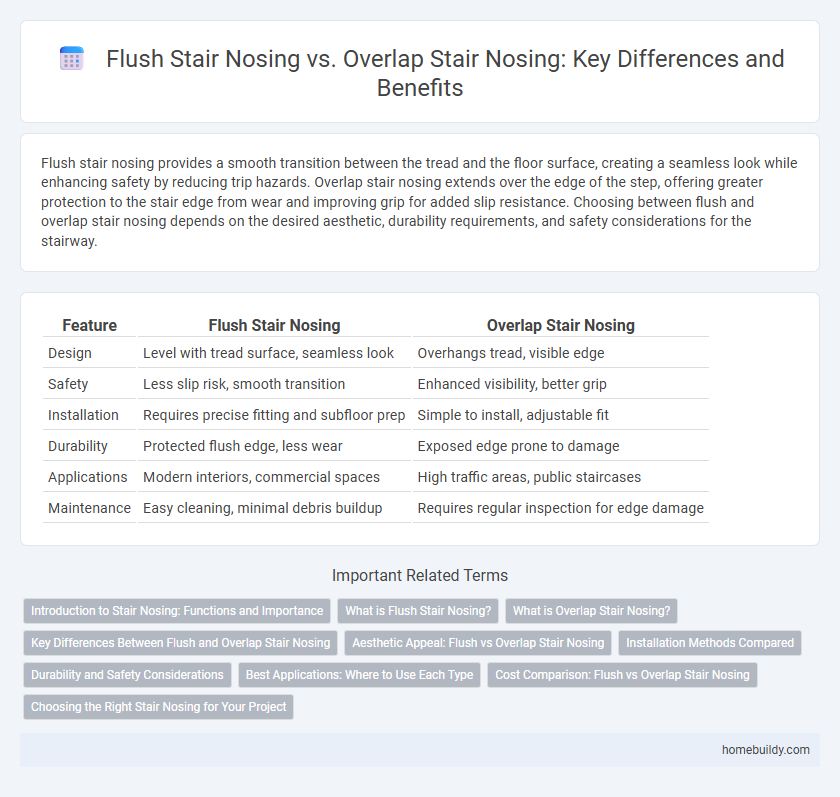Flush stair nosing provides a smooth transition between the tread and the floor surface, creating a seamless look while enhancing safety by reducing trip hazards. Overlap stair nosing extends over the edge of the step, offering greater protection to the stair edge from wear and improving grip for added slip resistance. Choosing between flush and overlap stair nosing depends on the desired aesthetic, durability requirements, and safety considerations for the stairway.
Table of Comparison
| Feature | Flush Stair Nosing | Overlap Stair Nosing |
|---|---|---|
| Design | Level with tread surface, seamless look | Overhangs tread, visible edge |
| Safety | Less slip risk, smooth transition | Enhanced visibility, better grip |
| Installation | Requires precise fitting and subfloor prep | Simple to install, adjustable fit |
| Durability | Protected flush edge, less wear | Exposed edge prone to damage |
| Applications | Modern interiors, commercial spaces | High traffic areas, public staircases |
| Maintenance | Easy cleaning, minimal debris buildup | Requires regular inspection for edge damage |
Introduction to Stair Nosing: Functions and Importance
Stair nosing enhances safety by providing a clear edge indication and improving traction to prevent slips and falls. Flush stair nosing aligns seamlessly with the tread surface, offering a smooth transition, while overlap stair nosing extends over the tread edge, providing added durability and protection against wear. Choosing the appropriate stair nosing type is essential for optimizing staircase functionality and ensuring long-term safety compliance.
What is Flush Stair Nosing?
Flush stair nosing is a type of stair edge trim designed to be level with the stair tread surface, creating a seamless transition that reduces tripping hazards. It is typically installed by embedding the nosing into the stair tread, making it nearly invisible and providing a clean, modern appearance. This design is ideal for high-traffic areas where safety and a sleek aesthetic are priorities.
What is Overlap Stair Nosing?
Overlap stair nosing is a type of stair edge protection that extends beyond the stair tread, overlapping the riser below to provide enhanced durability and slip resistance. It is typically installed on the front edge of a step, offering a visual cue for stair edges and improving safety by reducing wear and tear on both the tread and riser. Compared to flush stair nosing, overlap nosing provides better protection against damage and increased longevity in high-traffic areas.
Key Differences Between Flush and Overlap Stair Nosing
Flush stair nosing sits level with the stair tread, creating a seamless transition that reduces tripping hazards and enhances accessibility, ideal for commercial spaces needing ADA compliance. Overlap stair nosing extends beyond the tread edge, providing additional protection against wear and increasing stair durability, commonly used in high-traffic areas to prevent edge damage. Material thickness, installation method, and safety features differ significantly, with flush nosing prioritizing aesthetics and safety, while overlap nosing focuses on durability and tread protection.
Aesthetic Appeal: Flush vs Overlap Stair Nosing
Flush stair nosing offers a sleek, seamless appearance by aligning perfectly with the stair tread surface, enhancing modern and minimalist interior designs. Overlap stair nosing, with its visible edge extending beyond the stair tread, provides a more pronounced look that can add character and dimension to traditional or rustic settings. Choosing between flush and overlap nosing depends largely on the desired aesthetic effect and the architectural style of the space.
Installation Methods Compared
Flush stair nosing requires embedding into the stair tread for a seamless finish, demanding precise cutting and leveling during installation. Overlap stair nosing installs over the existing tread edge, offering easier application with surface mounting and less modification. The choice impacts installation time, tools needed, and compatibility with different stair materials.
Durability and Safety Considerations
Flush stair nosing offers enhanced durability by providing a seamless transition between steps, reducing wear and minimizing tripping hazards. Overlap stair nosing, while easier to install, may experience quicker wear on the edges and can pose slight safety risks due to raised profiles. For long-term safety and structural integrity, flush stair nosing is often preferred in high-traffic environments.
Best Applications: Where to Use Each Type
Flush stair nosing is best suited for environments demanding a seamless transition between stair tread and landing, such as in commercial buildings or residential spaces aiming for a sleek, modern finish that minimizes tripping hazards. Overlap stair nosing is ideal for high-traffic areas or exterior stairs where added durability and protection against wear and weather are critical, providing a robust edge that extends over the stair tread for enhanced safety and longevity. Selecting between flush and overlap stair nosing depends on usage intensity, aesthetic preference, and specific safety requirements of the staircase location.
Cost Comparison: Flush vs Overlap Stair Nosing
Flush stair nosing generally incurs higher upfront costs due to precision installation and the need for specialized materials to ensure a seamless fit with the stair tread. Overlap stair nosing tends to be more economical, as it simplifies installation by covering the edge, reducing labor time and material waste. Long-term maintenance costs for flush nosing may be lower because of its durability and cleaner appearance, while overlap nosing might require more frequent repairs or replacements due to exposed edges.
Choosing the Right Stair Nosing for Your Project
Flush stair nosing provides a seamless edge that aligns precisely with the stair tread surface, ideal for modern designs requiring clean lines and ADA compliance. Overlap stair nosing extends slightly over the tread edge, offering enhanced durability and slip resistance, making it suitable for high-traffic or industrial environments. Selecting the appropriate stair nosing depends on factors such as aesthetic preference, safety standards, and the specific wear conditions of the staircase.
Flush stair nosing vs overlap stair nosing Infographic

 homebuildy.com
homebuildy.com